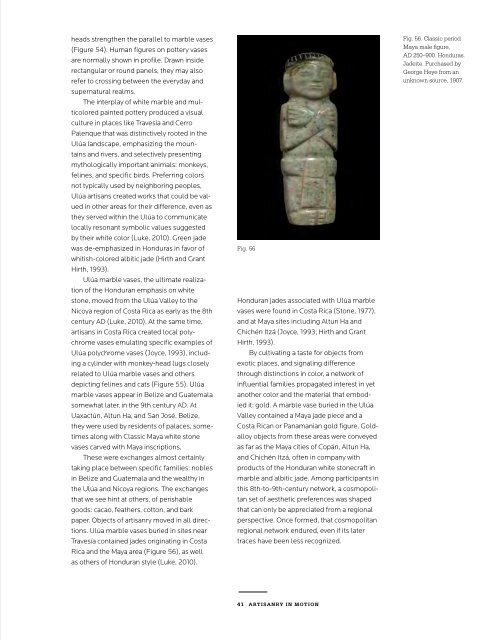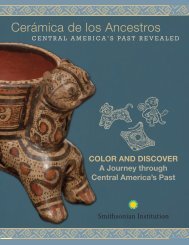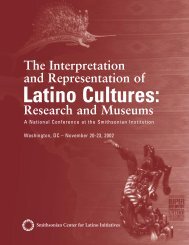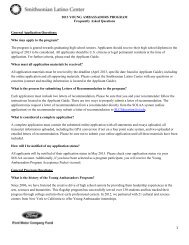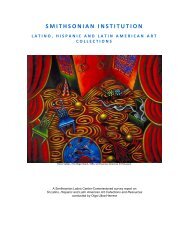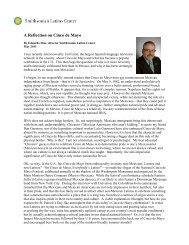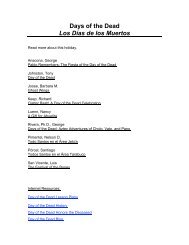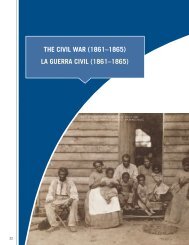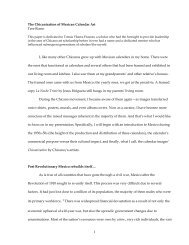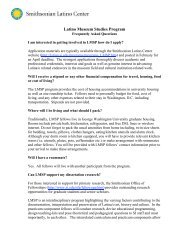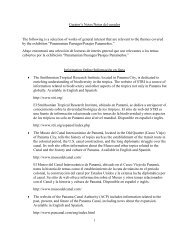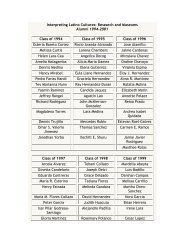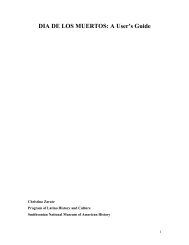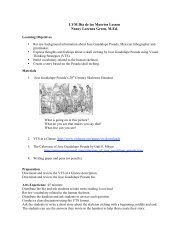Revealing Ancestral Central America - Smithsonian Latino Center ...
Revealing Ancestral Central America - Smithsonian Latino Center ...
Revealing Ancestral Central America - Smithsonian Latino Center ...
You also want an ePaper? Increase the reach of your titles
YUMPU automatically turns print PDFs into web optimized ePapers that Google loves.
heads strengthen the parallel to marble vases<br />
(Figure 54). Human figures on pottery vases<br />
are normally shown in profile. Drawn inside<br />
rectangular or round panels, they may also<br />
refer to crossing between the everyday and<br />
supernatural realms.<br />
The interplay of white marble and multicolored<br />
painted pottery produced a visual<br />
culture in places like Travesía and Cerro<br />
Palenque that was distinctively rooted in the<br />
Ulúa landscape, emphasizing the mountains<br />
and rivers, and selectively presenting<br />
mythologically important animals: monkeys,<br />
felines, and specific birds. Preferring colors<br />
not typically used by neighboring peoples,<br />
Ulúa artisans created works that could be valued<br />
in other areas for their difference, even as<br />
they served within the Ulúa to communicate<br />
locally resonant symbolic values suggested<br />
by their white color (Luke, 2010). Green jade<br />
was de-emphasized in Honduras in favor of<br />
whitish-colored albitic jade (Hirth and Grant<br />
Hirth, 1993).<br />
Ulúa marble vases, the ultimate realization<br />
of the Honduran emphasis on white<br />
stone, moved from the Ulúa Valley to the<br />
Nicoya region of Costa Rica as early as the 8th<br />
century AD (Luke, 2010). At the same time,<br />
artisans in Costa Rica created local polychrome<br />
vases emulating specific examples of<br />
Ulúa polychrome vases (Joyce, 1993), including<br />
a cylinder with monkey-head lugs closely<br />
related to Ulúa marble vases and others<br />
depicting felines and cats (Figure 55). Ulúa<br />
marble vases appear in Belize and Guatemala<br />
somewhat later, in the 9th century AD. At<br />
Uaxactún, Altun Ha, and San José, Belize,<br />
they were used by residents of palaces, sometimes<br />
along with Classic Maya white stone<br />
vases carved with Maya inscriptions.<br />
These were exchanges almost certainly<br />
taking place between specific families: nobles<br />
in Belize and Guatemala and the wealthy in<br />
the Ulúa and Nicoya regions. The exchanges<br />
that we see hint at others, of perishable<br />
goods: cacao, feathers, cotton, and bark<br />
paper. Objects of artisanry moved in all directions.<br />
Ulúa marble vases buried in sites near<br />
Travesía contained jades originating in Costa<br />
Rica and the Maya area (Figure 56), as well<br />
as others of Honduran style (Luke, 2010).<br />
Fig. 56<br />
Honduran jades associated with Ulúa marble<br />
vases were found in Costa Rica (Stone, 1977),<br />
and at Maya sites including Altun Ha and<br />
Chichén Itzá (Joyce, 1993; Hirth and Grant<br />
Hirth, 1993).<br />
By cultivating a taste for objects from<br />
exotic places, and signaling difference<br />
through distinctions in color, a network of<br />
influential families propagated interest in yet<br />
another color and the material that embodied<br />
it: gold. A marble vase buried in the Ulúa<br />
Valley contained a Maya jade piece and a<br />
Costa Rican or Panamanian gold figure. Goldalloy<br />
objects from these areas were conveyed<br />
as far as the Maya cities of Copán, Altun Ha,<br />
and Chichén Itzá, often in company with<br />
products of the Honduran white stonecraft in<br />
marble and albitic jade. Among participants in<br />
this 8th-to-9th-century network, a cosmopolitan<br />
set of aesthetic preferences was shaped<br />
that can only be appreciated from a regional<br />
perspective. Once formed, that cosmopolitan<br />
regional network endured, even if its later<br />
traces have been less recognized.<br />
Fig. 56. Classic period<br />
Maya male figure,<br />
AD 250–900. Honduras.<br />
Jadeite. Purchased by<br />
George Heye from an<br />
unknown source, 1907.<br />
41 ARTISANRY IN MOTION


